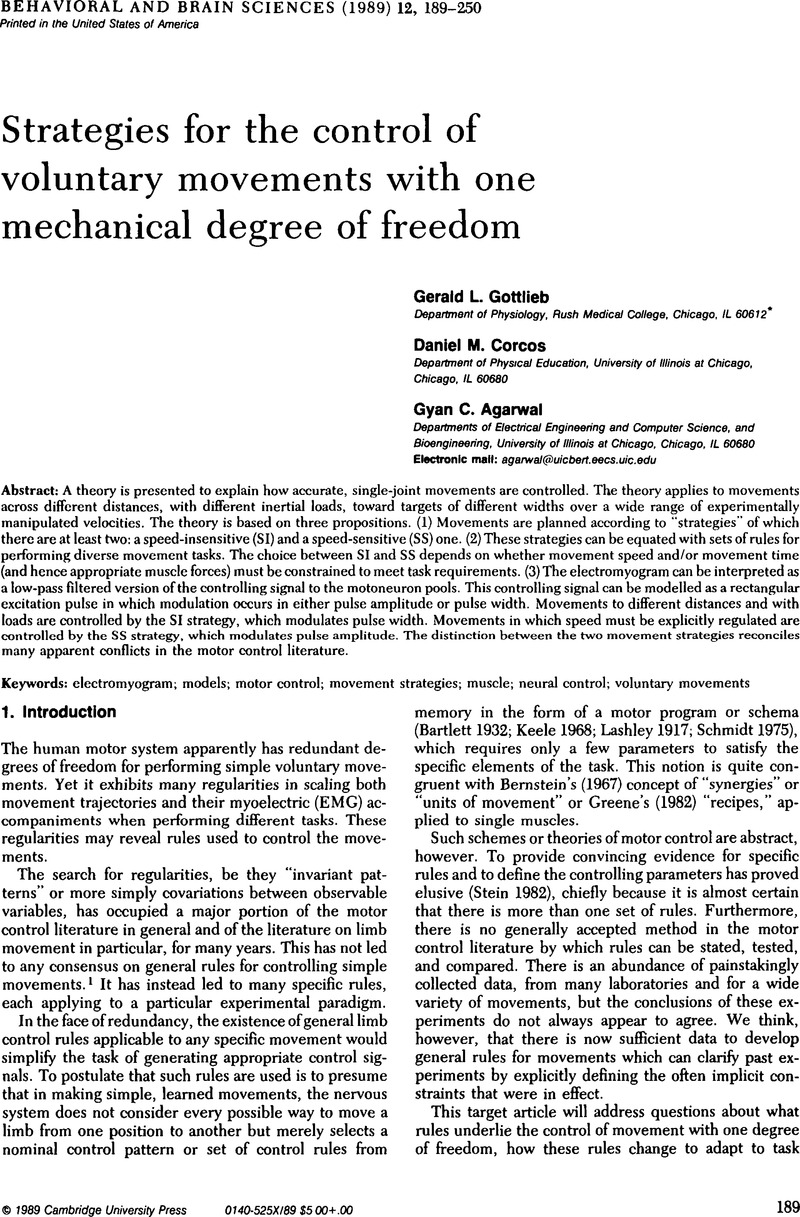Crossref Citations
This article has been cited by the following publications. This list is generated based on data provided by Crossref.
Jamison, J.Christopher
and
Caldwell, Graham E.
1994.
Dual degree of freedom tasks: Flexion effect on supination/pronation response.
Journal of Electromyography and Kinesiology,
Vol. 4,
Issue. 3,
p.
143.
Latash, Mark L.
1995.
Equilibrium-point control? Yes! Deterministic mechanisms of control? No!.
Behavioral and Brain Sciences,
Vol. 18,
Issue. 4,
p.
765.
Partridge, Lloyd D.
1995.
Let us accept a “controlled trade-off” model of motor control.
Behavioral and Brain Sciences,
Vol. 18,
Issue. 4,
p.
773.
Bonnard, Mireille
and
Pailhous, Jean
1995.
A few reasons why psychologlsts can adhere to Feldman and Levin's model.
Behavioral and Brain Sciences,
Vol. 18,
Issue. 4,
p.
746.
Levin, Mindy F.
and
Feldman, Anatol G.
1995.
The λ model for motor control: More than meets the eye.
Behavioral and Brain Sciences,
Vol. 18,
Issue. 4,
p.
786.
lngvaldsen, R.
and
Whiting, H.T.A.
1995.
Frameworks on shifting sands.
Behavioral and Brain Sciences,
Vol. 18,
Issue. 4,
p.
764.
Alexander, R. McN.
1995.
Tendon elasticity and positional control.
Behavioral and Brain Sciences,
Vol. 18,
Issue. 4,
p.
745.
Pribram, Karl H.
1995.
Position is everything?.
Behavioral and Brain Sciences,
Vol. 18,
Issue. 4,
p.
776.
Giszter, Simon
1995.
The case of the missing CVs: Multi-joint primitives.
Behavioral and Brain Sciences,
Vol. 18,
Issue. 4,
p.
755.
Morasso, Pietro
and
Sanguineti, Vittorio
1995.
Kinematic invariances and body schema.
Behavioral and Brain Sciences,
Vol. 18,
Issue. 4,
p.
769.
Haggard, Patrick
Miall, Chris
and
Stein, John
1995.
Twisted pairs: Does the motor system really care about joint configurations?.
Behavioral and Brain Sciences,
Vol. 18,
Issue. 4,
p.
758.
Gielen, C. C. A. M.
and
van Bolhuis, B.
1995.
Reciprocal and coactivation commands are not sufficient to describe muscle activation patterns.
Behavioral and Brain Sciences,
Vol. 18,
Issue. 4,
p.
754.
Kay, Bruce A.
1995.
Frames of reference interact and are task-dependent.
Behavioral and Brain Sciences,
Vol. 18,
Issue. 4,
p.
765.
Hatsopoulos, Nicholas G.
and
Warren, William H.
1995.
Do control variables exist?.
Behavioral and Brain Sciences,
Vol. 18,
Issue. 4,
p.
762.
Alexandrov, Alexey
Frolov, Alexander
and
Massion, Jean
1995.
Is the multi-joint pointing movement model applicable to equilibrium control during upper trunk movements?.
Behavioral and Brain Sciences,
Vol. 18,
Issue. 4,
p.
745.
Fikes, Thomas G.
and
Townsend, James T.
1995.
Moving models of motion forward: Explication and a new concept.
Behavioral and Brain Sciences,
Vol. 18,
Issue. 4,
p.
751.
Dean, Jeffrey
1995.
The lambda model is only one piece in the motor control puzzle.
Behavioral and Brain Sciences,
Vol. 18,
Issue. 4,
p.
749.
Lestienne, F.
Ghafouri, M.
and
Thullier, F.
1995.
What does body configuration in microgravity tell us about the contribution of intra- and extrapersonal frames of reference for motor control?.
Behavioral and Brain Sciences,
Vol. 18,
Issue. 4,
p.
766.
Flanagan, J. Randall
Tresilian, James R.
and
Wing, Alan M.
1995.
Grip force adjustments during rapid hand movements suggest that detailed movement kinematics are predicted.
Behavioral and Brain Sciences,
Vol. 18,
Issue. 4,
p.
753.
Pagano, Christopher C.
and
Bingham, Geoffrey P.
1995.
Spatial frames for motor control would be commensurate with spatial frames for vision and proprioception, but what about control of energy flows?.
Behavioral and Brain Sciences,
Vol. 18,
Issue. 4,
p.
773.


